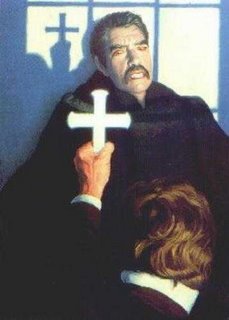 At the time when Stoker wrote “Dracula”, rather than being primarily an agnostic/atheist country that pretends it is a Christian stronghold, Britain was a Christian country. Other faiths were foreign and strange.
At the time when Stoker wrote “Dracula”, rather than being primarily an agnostic/atheist country that pretends it is a Christian stronghold, Britain was a Christian country. Other faiths were foreign and strange.
Dracula is clearly, in Stoker’s eyes, a representation of the foreigner come to Britain to corrupt all that was of the Empire. In the novel a frightened peasant offers Harker, who is journeying to meet with his client Count Dracula, a crucifix and the attitude of Victorian England comes shining through:
“She then rose and dried her eyes, and taking a crucifix from her neck offered it to me.
“I did not know what to do, for, as an English Churchman, I have been taught to regard such things as in some measure idolatrous, and yet it seemed so ungracious to refuse an old lady meaning so well and in such a state of mind.
She saw, I suppose, the doubt in my face, for she put the rosary round my neck and said, ‘For your mother’s sake,’ and went out of the room.”
Bram Stoker - Dracula
One hero character in Dracula who is not of that Victorian British cast is Quincey Morris. Yet Stoker under uses our colonial friend until it is such time that he sacrifices himself for the greater glory of the Empire’s sons.
We also have the brave Dutchman, Van Helsing. Yet it is perhaps because of his continental roots that this man of science can so easily believe in the supernatural. As noted earlier it is of interest that, despite the use of Christian symbols and paraphernalia, Stoker’s novel is noticeably lacking in clergy. These implements are not wielded by a priest, but by a man of science. This dichotomy of science and religion within the character of Van Helsing is fascinating to say the least, and probably deserving of further study.
To Stoker the world was a very different place to that we see today. Yet as the world has become smaller, the different faiths of the world are all around us. Most of us are comfortable with this multi-cultural and multi-faith society. As we have developed, so to, it seems, must the vampire.
At first there was the question, would a vampire of a different faith be affected by a purely Christian symbol? This was tackled most amusingly in the Polanski epic “The Fearless Vampire Killers, or Pardon me, but your fangs are in my neck.” (1967). The scene I refer to is, of course, the marvellous scene when Jewish vampire Alfie Bass is confronted by a cross. “Oy vay, have you got the wrong vampire!” he retorts.
This comedic use of symbols of faith is also used in “Love at First Bite” (1979). The strangely perma-tanned Dracula, played by George Hamilton, is faced with a Star of David. “What do you think of that?” Cries Rosenberg, our would be vampire slayer. Unfortunately for the hapless hunter, Dracula is not Jewish, however he does cover his face until he realises that it is not a crucifix presented to him. “I would say, leave Cindy alone and find yourself a nice Jewish girl, Doctor!” retorts the count.
In Chinese vampire movies, such as “Mr Vampire” (1985) prayer scrolls and other traditional Chinese items are used to combat the evil, rather than Western religious symbols. In these movies we also find a very different breed of vampire. These creatures do not walk, as the living dead in Western movies do; more often than not they hop. In many such movies they detect their victims by their breath, so holding ones breath effectively makes the vampire blind. This breath detection system can lead to amusing comedic scenes, such as the clip from “Mr Vampire” which can be found here. Yet there has been a move to a more traditionally Western version of the myth in movies such as “The Twins Effect” (2003) and, of course, an importing of more Christian iconography as a result.
Saturday, March 11, 2006
Vampires and the Cross Part Two
Posted by
Taliesin_ttlg
at
2:06 AM
![]()
Subscribe to:
Post Comments (Atom)
















No comments:
Post a Comment